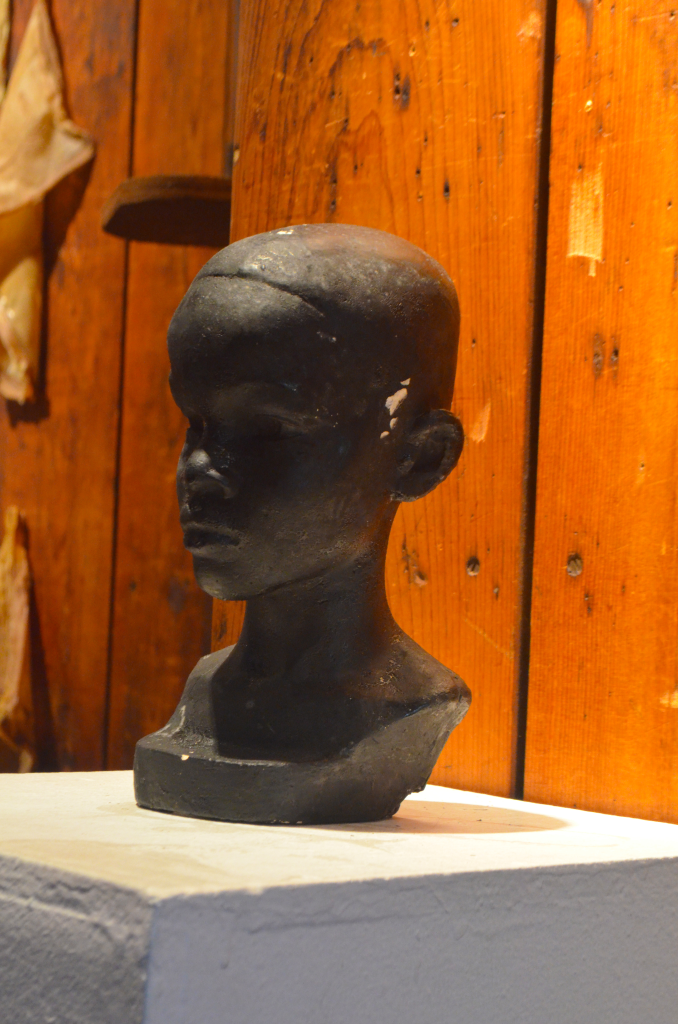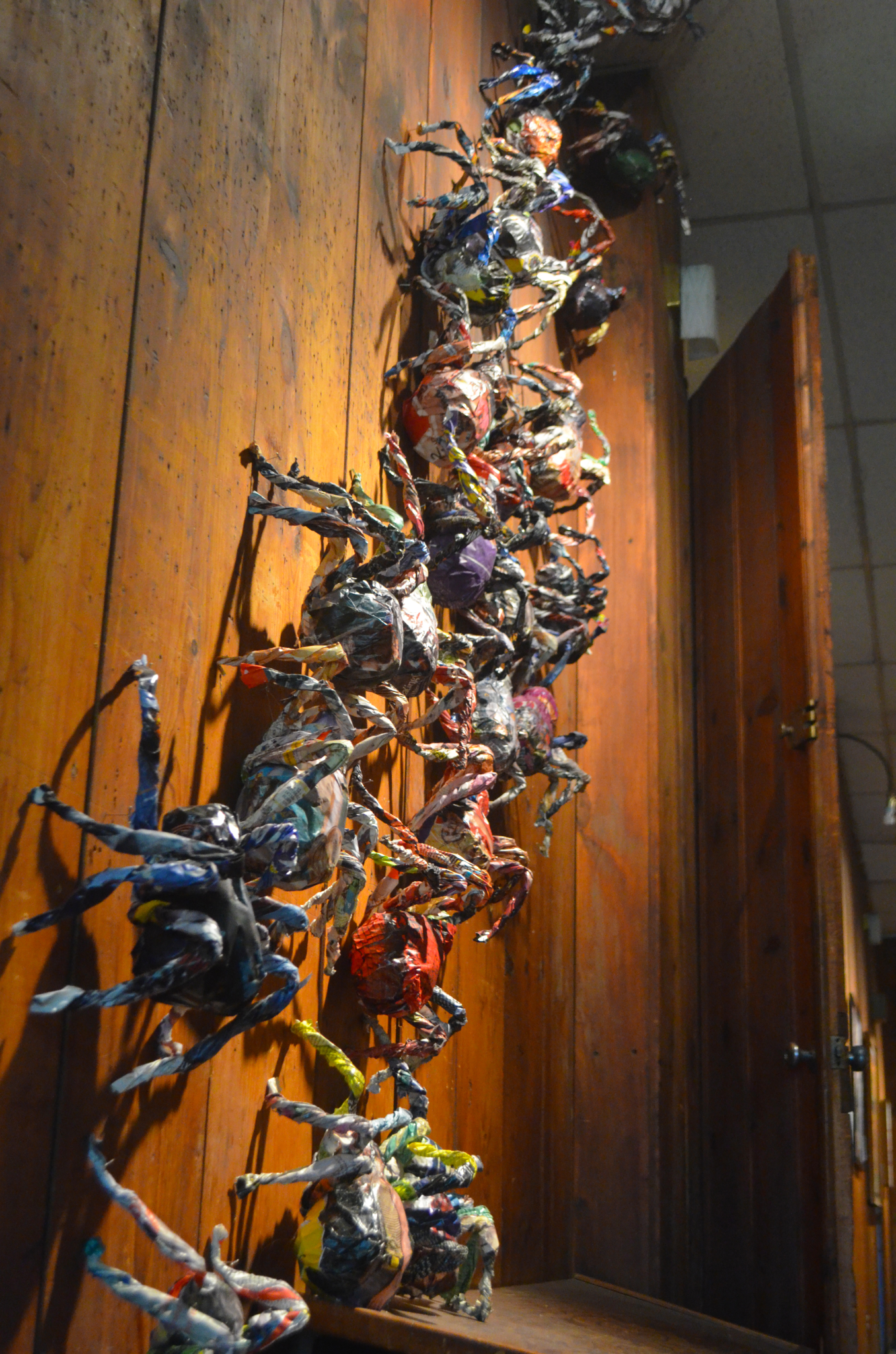The walls at the South Side Community Art Center are almost as important as the objects that hang from them. The stained and pockmarked wood panels were one of the first features Clinton Nichols, program manager at SSCAC, pointed out upon entering into the main exhibition room. They’re also the web banner on SSCAC’s art historical blog, Art of a Community Speaks.” Nearly a year ago, in a similar exhibition overview, an article in the Weekly also made them its starting point.
It’s been said that each scuff and nail hole is a document in itself. Visitors appreciate the carpentry because the art center’s exhibition history is written on the building’s surface. (“Margaret Burroughs hung her woodcut here,” they shout.) But the SSCAC’s current 75th Anniversary show, “From the Hearth,” flips this thinking. It shows off objects that are themselves as marked-up and time-worn as the struts and beams behind them.
Take Charles Davis’s “Back Street,” an oil painting on canvas from 1940, as an example. It’s a sketchy, loosely-worked picture of a Bronzeville family behind their house, painted the year of SSCAC’s inauguration. The father’s swinging a mallet near the center; kids are playing on planks next to some unfinished masonry. New redbrick apartment buildings line the horizon. Time, however, threatens to undo the dad’s home-improvement project.
Light and moisture have caused what might have once been a very vibrant palette to sink, darken, and yellow. Blues are greens, and reds are dusty. The painted surface appears to buckle in places. It looks more like Davis went at it with crayons or pastels than with a brush. Areas near the dad have fractured outright. A few flakes of paint have fallen off, revealing the white canvas below. What might have once been seen as a new picket fence is now a fixer-upper.
The same can be said for the Richmond Barthé bust of a shoe shine boy, as well as a few oil paintings by Margaret Burroughs. Barthé’s plaster sculpture has lost small patches from its original coat of acrylic paint; it’s tough to tell what Boroughs might have scraped away herself and what’s been lost over successive handlings.

By exhibiting these works, “From the Hearth” embraces object condition instead of concealing it. The movement is partly a gesture to donors: the SSCAC has embarked on an “Adopt a Work” campaign to raise money for professional restoration. An extra line of explanatory text accompanies the labels to pieces that qualify. But the show also reads as a quiet salute to a years-long project by the SSCAC to comprehensively catalog their collection, to which Davis, Barthé, and Burroughs all permanently belong.
“It’s so impressive that the collection, the archives, are still at the center,” said Marissa Baker, a former collections intern. Baker contributed to this project from 2013 to 2014, in the years leading up to the 75th anniversary. “They’re still at the same building, in the same community. That makes it a remarkable resource.”
Baker teamed with University of Chicago professor Rebecca Zorach to continue the work of previous interns and a consulting conservationist. They were working under a grant from the National Trust for Historic Preservation.
“The scope of the project was ensuring that the collection was not just preserved, but well-documented,” she explained. “I would read Board of Trustees notes and documents from the founding days…they had flyers from the exhibitions, they had beautiful programs from the Artists and Models Ball.”
Baker compiled articles about the Center’s specific strengths, and posted them online to a public blog. She was able to conduct thorough research, based firmly on the works themselves, since the center keeps everything located conveniently on-site.
“Across the hall was the collection. I could read something from the archive and then look at the object!”
During her stay, she honed in on two key areas: first the Center’s founding during the 1930s and 1940s, and then the Black Arts Movement in the 1960s and 1970s. Baker considers the art center’s inventory of AfriCOBRA prints to be “one of the more impressive collections in the country,” competing with the Brooklyn Museum or LACMA.
“There was a resurgence at the Center in the 1960s, and an interest in it as a place where cultural production could happen,” she said. “That’s a movement in visual art that’s just beginning to be documented. As more art history is being written, now, the South Side Community Art Center will emerge as a site where that creative activity was happening.”
This turns out to be the other half of “From the Hearth.” In addition to artists like Davis, Barthé, and Burroughs, the exhibition features more recent artists like Ralph Arnold and Barbara Jones-Hogu, as well as works from contemporary makers like Nnenna Okore, Faheem Majeed, and Krista Franklin. Majeed and Franklin both share close ties to the center itself: Majeed was its previous executive director, while Franklin was a teaching artist who first introduced the show’s two young curators—Kara Franco and Lamar Gayles—to the SSCAC.
The presence of Majeed’s or Franklin’s work in “From the Hearth” verifies that the SSCAC is still a nexus for the same kind of undertakings that Baker identified in the 1960s. Just as the walls display the marks of previous exhibitions, or the Barthé bust marks time in its scratches and abrasions, Majeed’s two bright yellow replicas of that same bust index the Center’s influence on his present-day practice.
Majeed essentially updates Barthé’s straightforward, anthropological perspective to speak to current concerns of neighborhood violence. Majeed identifies the yellow color of the two reproductive sculptures with caution signs. He reiterates the self-care that Barthé’s boy—then as now—has to exercise to stay safe, happy, and healthy.
In situating his replicas over the exhibition room’s fireplace, Majeed goes a step further. He offers credit where credit is due. The center’s preservation of Barthé’s boy gave him a useful visual shorthand by which he could express one aspect of his larger artistic idea. Each of the two heads, shorn off at the mouth, appears to grow up and out of the mantelpiece. By making his work actually look like a part of the Center’s material space, Majeed makes clear how his thinking has in part “arisen” from contact with the SSCAC’s robust holdings.
Nnenna Okore’s “Spiders” comes as a coda for the SSCAC’s role as inspiration and incubator. Twisting from ground to ceiling, “Spiders” is a monumental column of individual spider puppets, made from recycled papers. Each is about the size of two fists, sporting spindly, twisted legs. The spiders follow the contours of the radiator, doorframe, and ceiling. They all travel, pack-like, in the same direction. The installation makes excellent use of the wooden walls. Metal dissection pins, like you’d find in a laboratory room, fix each spider firmly to the surface, defying gravity.
Okore encourages the viewer to think about spiders as spinners, as creatures that pull together various strands and elements. It’s in this light that her art provides a framework for sizing up the SSCAC’s seventy-five year-old collection. Okore’s colored magazine scraps can be considered a kind of archival matter of their own. Her source materials may not be in the best of conditions, but they’ve been lovingly pulled together into an artistic apparatus that encourages reading and reflection.
Whether at the level of museum or maker, a continual process of gathering, turning over, and reshuffling can generate rewarding and attractive conclusions. “From the Hearth” recognizes that while many of the SSCAC’s objects date back to the 1940s, and very visibly bear the passage of that time, they still have a lot to do for future generations. They are, in effect, still quite young.



